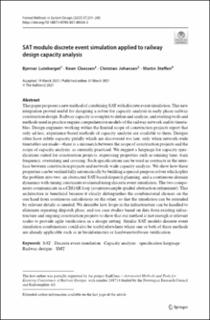| dc.contributor.author | Luteberget, Bjørnar Steinnes | |
| dc.contributor.author | Claessen, Koen | |
| dc.contributor.author | Johansen, Christian | |
| dc.contributor.author | Steffen, Martin | |
| dc.date.accessioned | 2022-04-29T12:12:42Z | |
| dc.date.available | 2022-04-29T12:12:42Z | |
| dc.date.created | 2021-07-29T13:10:30Z | |
| dc.date.issued | 2021 | |
| dc.identifier.citation | Formal methods in system design. 2021, 57, 211-245. | en_US |
| dc.identifier.issn | 0925-9856 | |
| dc.identifier.uri | https://hdl.handle.net/11250/2993424 | |
| dc.description.abstract | This paper proposes a new method of combining SAT with discrete event simulation. This new integration proved useful for designing a solver for capacity analysis in early phase railway construction design. Railway capacity is complex to define and analyze, and existing tools and methods used in practice require comprehensive models of the railway network and its timetables. Design engineers working within the limited scope of construction projects report that only ad-hoc, experience-based methods of capacity analysis are available to them. Designs often have subtle capacity pitfalls which are discovered too late, only when network-wide timetables are made—there is a mismatch between the scope of construction projects and the scope of capacity analysis, as currently practiced. We suggest a language for capacity specifications suited for construction projects, expressing properties such as running time, train frequency, overtaking and crossing. Such specifications can be used as contracts in the interface between construction projects and network-wide capacity analysis. We show how these properties can be verified fully automatically by building a special-purpose solver which splits the problem into two: an abstracted SAT-based dispatch planning, and a continuous-domain dynamics with timing constraints evaluated using discrete event simulation. The two components communicate in a CEGAR loop (counterexample-guided abstraction refinement). This architecture is beneficial because it clearly distinguishes the combinatorial choices on the one hand from continuous calculations on the other, so that the simulation can be extended by relevant details as needed. We describe how loops in the infrastructure can be handled to eliminate repeating dispatch plans, and use case studies based on data from existing infrastructure and ongoing construction projects to show that our method is fast enough at relevant scales to provide agile verification in a design setting. Similar SAT modulo discrete event simulation combinations could also be useful elsewhere where one or both of these methods are already applicable such as in bioinformatics or hardware/software verification. | en_US |
| dc.language.iso | eng | en_US |
| dc.publisher | Springer | en_US |
| dc.rights | Navngivelse 4.0 Internasjonal | * |
| dc.rights.uri | http://creativecommons.org/licenses/by/4.0/deed.no | * |
| dc.subject | SAT | en_US |
| dc.subject | Discrete event simulation | en_US |
| dc.subject | Capacity analysis | en_US |
| dc.subject | Specification language | en_US |
| dc.subject | Railway designs | en_US |
| dc.subject | SMT | en_US |
| dc.title | SAT modulo discrete event simulation applied to railway design capacity analysis | en_US |
| dc.type | Peer reviewed | en_US |
| dc.type | Journal article | en_US |
| dc.description.version | publishedVersion | en_US |
| dc.rights.holder | © The Author(s) 2021. This article is licensed under a Creative Commons Attribution 4.0 International License, which permits use, sharing, adaptation, distribution and reproduction in any medium or format, as long as you give appropriate credit to the original author(s) and the source, provide a link to the Creative Commons licence, and indicate if changes were made. The images or other third party material in this article are included in the article’s Creative Commons licence, unless indicated otherwise in a credit line to the material. If material is not included in the article’s Creative Commons licence and your intended use is not permitted by statutory regulation or exceeds the permitted use, you will need to obtain permission directly from the copyright holder. To view a copy of this licence, visit http://creativecommons.org/licenses/by/4.0/. | en_US |
| dc.source.pagenumber | 211-245 | en_US |
| dc.source.volume | 57 | en_US |
| dc.source.journal | Formal methods in system design | en_US |
| dc.identifier.doi | 10.1007/s10703-021-00368-2 | |
| dc.identifier.cristin | 1923018 | |
| cristin.ispublished | true | |
| cristin.fulltext | original | |
| cristin.qualitycode | 2 | |

